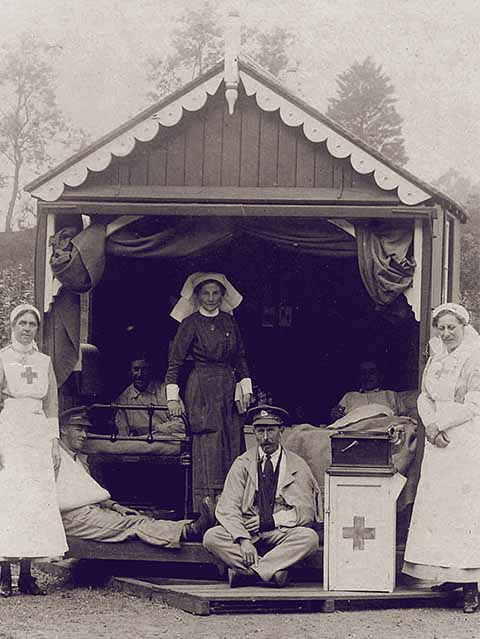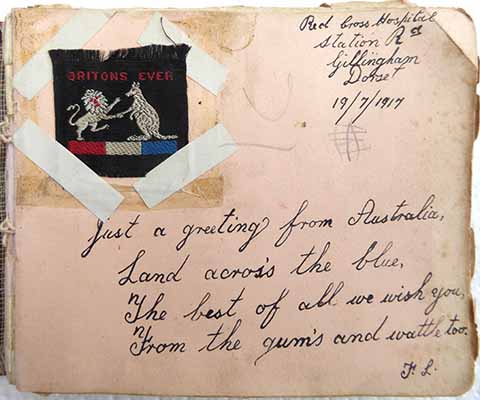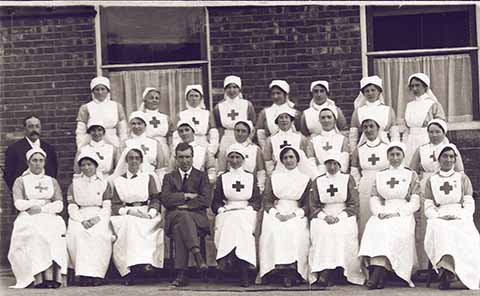The hospital that came then went
David Lloyd maps the history of the World War 1 Red Cross Society hospital in Gillingham
Published in August ’19
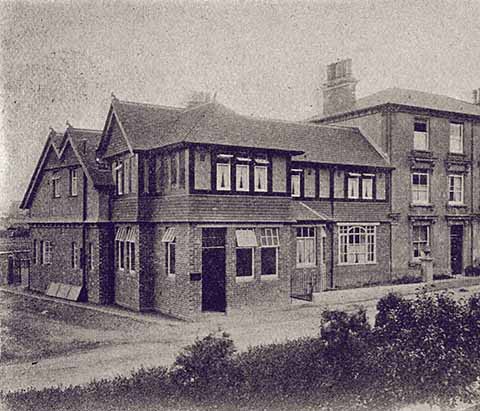
Miss Dunn’s High School for Girls, corner of Station Road and Buckingham Road, used as Red Cross Hospital 1914-1919
‘A German invading force has landed at Burnham, Somerset, and is marching on London. A British defending force is concentrating on Salisbury Plain.’
Those two alarming sentences were the beginning of an announcement from Lady Pelly, of Thorngrove House, Gillingham, on Saturday 25 July 1914 to Commandants of the men’s and women’s Voluntary Aid Detachment in the Shaftesbury division of the Dorset branch of the Red Cross Society. Messages and instructions were in turn communicated to individual members. Lady workers from Gillingham, Shaftesbury and surrounding villages were mobilised and reported to the improvised hospital at Thorngrove.
Commandant C F Ellerton, of the Gillingham men’s detachment, received a message that
they were to collect the ‘wounded’ and take them to Thorngrove.
This was the scenario of the Red Cross field-day held in the grounds of the home of Sir Harold and Lady Pelly. The announcement continued, ‘An advance party of Dorset Territorials and Yeomanry is marching to join the main force at Salisbury. At East Stour they have come into contact with a reconnoitring party of the invaders. After a sharp conflict the enemy has been beaten off. The British force proceeds on its way, leaving the wounded to be dealt with locally, preliminary to entraining for base hospital at Exeter.’
The stage was therefore set for an exercise of great importance. A temporary rest-station, equipped and conducted with utmost precision, was situated just within the gates at Thorngrove. A huge tent in front of the house was even more realistic, being divided into surgical and hospital wards. A number of Red Cross ladies attended in their familiar nurses’ uniform – print dresses, white aprons and caps and the Red Cross on the breast. In late afternoon the ‘casualties’ arrived with a variety of ailments and injuries.
The demonstrations included first aid, cooking, home nursing and stretcher work. An ‘operation’ was carried out by the medical officers. It was later reported that the whole exercise had proved highly instructive and interesting and emphasised the nobleness of the Red Cross work and its far-reaching benefits in the time of necessity. Earlier in the year, at a Red Cross bazaar in aid of the local detachment funds, Viscountess Portman (President of the Dorset branch of Soldiers & Sailors Families’ Association) had paid tribute to the work of the Red Cross in and around Gillingham. She referred to the hard preparatory work undertaken by the commandants and the dedication of the nurses who had attended lectures and studied to gain the necessary training certificates. She hoped they would never be wanted, except that they were wanted every day and in everyday life. Little did she know that within months they would be wanted in time of war.
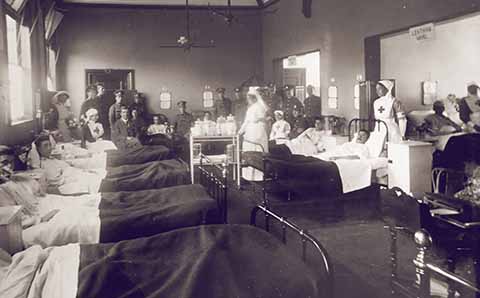
Station Road Hospital ward. Leatham Ward to the right – Mrs Leatham was the Commandant, succeeded by her daughter Miss Leatham.
The national background in July was of course murmurings of conflict in Europe, started by the assassination of Archduke Franz Ferdinand and his wife, Sophie, in Sarajevo on 28 June. Over the following weeks various declarations of war were made, culminating in Britain declaring war on Germany on 4 August and the first British troops landing in France three days later.
During August, at a meeting of the commandants, Lady Pelly, president of the division, stated that the Market Hall, the Grammar School and the Council schools had been generously placed at their disposal. The townspeople offered to lend beds, bed linen and other necessary articles. Commandant Ellerton appealed for recruits and about fifty men offered their services for the Voluntary Aid Detachment.
In October, members of the Gillingham detachment of the Red Cross Society were notified that in response to the offer made to provide accommodation and medical aid, they were to receive the care of sick soldiers from the recruits of Kitchener’s Army. The proprietors of the Girl’s School in Station Road gave up their commodious premises for the purpose and, together with the house next door, the whole made an ideal emergency hospital. Through the kindness of local residents providing beds, furniture etc and many willing hands, the Commandant, Mrs Leatham, had the hospital ready with 25 beds by 20 October. The following day a motor ambulance brought the first casualties: five patients, two of which were stretcher cases.
The Government paid two shillings per day per patient, which was insufficient to cover all needs, so an appeal went out for provisions, newspapers, cigarettes, flowers and monetary funds.
Meanwhile, the members of the Bourton Red Cross Society secured Plank House in Wyke Street, Gillingham, as a hospital. This was lent by Henry Wyld, a local solicitor. The first Commandant was Lady Parr. There were twelve beds, six of which were in open-air shelters in the garden and were chiefly used for septic and tuberculous cases. Mobilised on 30 October, the hospital took patients from the military hospitals at Codford, Sutton Veny, Cosham and Bournemouth and from troops billeted in the neighbourhood. In early November six patients, three with diphtheria, arrived from Codford Camp.
From March to November 1916, Mrs Carlton Cross was the Acting Commandant and the number of beds had by then increased to 24 with a very good operating theatre. 51 major operations were performed, including amputations, operations on bones, joints and arteries and for hernia, appendicitis, empyema and haemorrhoids. Bacterial examinations were deemed necessary in 96 cases and 27 cases were treated by autogenous vaccines.
Of the four deaths recorded, two were due to accidents occurring in the neighbourhood, both patients being dead on admission, and the other two were overseas patients who both succumbed to septicaemia following septic wounds.
The hospitals were part of the Shaftesbury Division of the Red Cross consisting of four centres: Station Road (Dorset/98), Plank House (Dorset/50), Mere (Dorset/16) and the Retreat, Shaftesbury (Dorset/10). Men from the Voluntary Aid Detachment received the sick cases and transported the patients to the appropriate hospital. The demands of the Army meant that the young men disappeared and the older men could not spare the time for passing examinations. As a result, there was never a sufficient quota available at one time and the detachment was never properly registered. However, those that were available, including boys from the Grammar School, did a sterling job with transport and general help. Many of the patients arrived at Gillingham Station.
Disaster struck in 1917 when on 28 June a violent thunderstorm and unprecedented rainfall caused the dam at Gaspar to burst and the swollen river Stour then swept through Bourton towards Gillingham. Plank House received the full shock of the torrent. The night nurse roused the men in the open-air shelters when the water was ankle-deep.
Dr Farnfield was alerted, but by the time he arrived the water was breast-high and a fight for life began. Two soldiers succeeded in opening the gates and helped the doctor to battle through the rushing weight of water. Due to the heroic efforts of the staff and the soldiers no lives were lost.
Plank House Hospital closed on 10 January 1919. Local doctors, nurses and ambulance drivers had cared for 616 Army sick and wounded by that time. Mrs Farnfield, the matron, was decorated by Queen Alexandra with the Royal
Red Cross.
In December 1917, the Station Road Hospital was enlarged to 35 beds. In May 1918, with the help of a new ward in the form of a hut (named the Evan Down Ward) attached to the main building, accommodation was increased to 50 beds. With the benefit of further extensions, there were 62 beds by November 1918. The Station Road Hospital closed on 6 March 1919. The total number of patients admitted was noted as 792, but local newspaper reports indicated that the figure was a lot higher. In April 1919, Messrs Senior & Godwin were instructed to sell the freehold property. Also included for sale was the hut extension (Evan Down Ward). This, however, was presented by the Hospital Trustees to the Gillingham branch of the Comrades of the Great War, founded earlier in the year. The new clubhouse became so successful that it could not accommodate everyone. The branch secured a site from the Governors of the Grammar School and the ‘hut’ was moved from Buckingham Road to School Lane and extended. Originally named the Earl Haig Club, it is today known as the Royal British Legion Club.
On 3 August 2014, blue plaques were placed by Gillingham Local History Society on the former hospital buildings and British Legion clubhouse to recognise the part they played during World War 1.
All images courtesy of the author and Gillingham Museum
